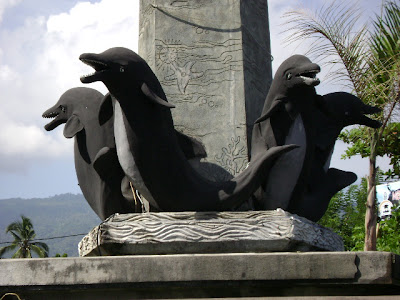 |
| Brahmavihara Arama |
"This blog offers essential insights into Bali’s top tourist spots and best hotels, helping travelers plan their perfect visit."
Labels
Monday, 20 May 2013
Brahmavihara Arama
Sunday, 12 May 2013
Singsing waterfall
Monday, 29 April 2013
Ponjok Batu Temple
Ponjok Batu Temple is a sacred site located on a rocky headland, radiating natural beauty with its rock crevices, flourishing frangipani trees, and lush shrubs. In Balinese, "Ponjok Batu" means "Rocky Headland," reflecting the geographic features of this location. This temple serves not only as a place of worship for the Balinese Hindu community but also as a captivating natural tourist destination, combining both spiritual depth and scenic charm.
The temple functions as a public sanctuary where both locals and visitors come to offer prayers and seek blessings for protection. Ponjok Batu Temple is an essential part of Bali's rich cultural and spiritual heritage, which remains well-preserved to this day. Its serene and sacred atmosphere provides inner peace and tranquility to everyone who visits, whether for spiritual reasons or simply to enjoy the surrounding natural beauty.
From the temple's front courtyard, a road connects Singaraja to Amlapura, bordering the temple area. To the north, the vast, calm Java Sea stretches out, offering a soothing view that brings peace of mind and a sense of reflection for visitors. This tranquil seascape often inspires those seeking peace or a moment of contemplation amidst the stunning natural surroundings.
The beauty of the temple is further enhanced by the presence of ancient trees growing on the surrounding hills. These trees not only add to the natural charm but also create a cool, shady environment for visitors. Several natural springs are scattered around the temple area, which the local community uses for their daily needs, making the temple an integral part of local life.
Ponjok Batu Temple is located approximately 24 kilometers east of Singaraja, in the village of Pacung, Tejakula District. Its location in a rural setting adds to its appeal as a peaceful place, far from the bustling city life. The entire temple structure is made from natural stone found in the surrounding area, blending seamlessly with the environment. This unique architectural design sets Ponjok Batu Temple apart from other temples in Bali, with a strong connection to nature and traditional elements.
In addition to being a place of worship, Ponjok Batu Temple is also a must-visit natural tourist destination. The combination of natural beauty, peaceful surroundings, and the spiritual values within the temple creates a holistic experience for visitors. Whether they come to pray, meditate, or simply enjoy the scenic views, Ponjok Batu Temple offers an experience that touches the heart and pleases the eye.
The temple also attracts tourists interested in learning more about Bali's culture and spirituality. It symbolizes the harmony between humans, nature, and God, in line with the Balinese Hindu philosophy of Tri Hita Karana. With all its charms, Ponjok Batu Temple is a place that should be on the list of anyone seeking the peace and natural beauty of authentic Bali.
Monday, 22 April 2013
Banyuwedang Hot springs
Friday, 19 April 2013
Lake Buyan and Lake Tamblingan
 |
| The Buyan lake |
 |
| The Tamblingan lake |
Lake Buyan and Lake Tamblingan: Serene Gems of Sukasada
Lake Buyan and Lake Tamblingan, nestled in the Sukasada district just 21 km south of Singaraja City, are easily accessible via the Denpasar-Singaraja road. Situated at an altitude of approximately 1,000 meters above sea level, these lakes are renowned for their cool, refreshing climate, which can become quite chilly at night.
Tamblingan Lake is conveniently reached via a junction leading to Munduk Village, allowing visitors to enjoy stunning panoramic views of both lakes along the way. This scenic route enhances the experience, making the journey to the lakes just as enjoyable as the destination itself.
Facilities around the lakes include ample parking near the shoreline, where visitors can also rent boats for fishing or leisurely exploration. Additionally, accommodation options are available for those wishing to extend their stay and fully immerse themselves in this tranquil environment.
The majority of tourists visiting Lake Buyan and Lake Tamblingan tend to be international travelers, often arriving in private vehicles or with dedicated drivers. This creates a more personalized experience as they explore the breathtaking natural surroundings.
Strategically located, Lake Buyan and Lake Tamblingan are flanked by three renowned attractions: the iconic Ulun Danu Beratan Temple, the stunning Gitgit Waterfalls, and the beautiful Lovina Beach. This prime location makes the lakes an ideal stop for those exploring Bali’s rich cultural and natural offerings, providing a perfect blend of relaxation and adventure in one unforgettable visit.
Wednesday, 17 April 2013
Pulaki Temple
 |
| Pulaki Temple |
Tourism in Lovina Beach
 |
| Statues of Dolphins in Lovina Beach |
 |
| Sunrise at Lovina Beach |
5 hotel tepi pantai terbaik di area Jimbaran, Bali
Berikut adalah 5 hotel tepi pantai terbaik di area Jimbaran, Bali, yang menawarkan kenyamanan dan pemandangan indah: Four Seasons Resort Ba...
-
The hot springs are located in the village Penatahan, Penebel District, approximately 13 km away from the city to the north tab...
-
Sunrise at Amed beach Amed Beach is located on the eastern part of Bali, precisely in the Abang district, Karangasem Regency. Su...
-
Brahmavihara Arama Brahmavihara-Arama, better known by the name of Buddha banjar monastery which is the biggest Buddha monastery in...






